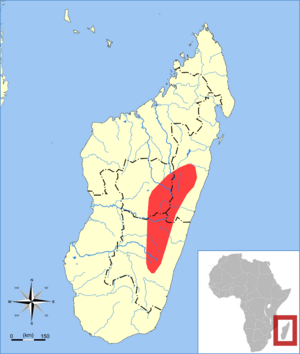Web-footed tenrec facts for kids
Quick facts for kids Web-footed tenrec |
|
|---|---|
| Conservation status | |
| Scientific classification | |
| Genus: |
Microgale
|
| Species: |
mergulus
|
 |
|
| Web-footed tenrec range | |
| Synonyms | |
|
Limnogale mergulus |
|
The web-footed tenrec, also called the Malagasy otter shrew or aquatic tenrec (Microgale mergulus), is a special animal found only in eastern Madagascar. It's the only tenrec known to live partly in water, just like the otter shrews in Africa.
These unique creatures grow to be about 25 to 39 centimeters long. For a while, people thought they had disappeared forever! Web-footed tenrecs enjoy eating crabs, water insects, and crayfish. Sadly, their numbers are low, and they are considered a vulnerable species.
Contents
Life of the Web-footed Tenrec
The web-footed tenrec is a shy animal that only comes out at night. During the day, it rests in burrows it digs along stream banks. When night falls, it leaves its home to search for food.
These tenrecs stick close to waterways. They move along streams and even dive into the water. Scientists have used special tracking collars to learn about them. Some tenrecs travel over 1,100 meters along stream channels. Others might patrol about 500 meters. In just one night, a web-footed tenrec can travel up to 1,550 meters along the water, looking for its next meal!
What Do Web-footed Tenrecs Eat?
Microgale mergulus lives only in the streams of eastern Madagascar. It mainly eats insects, so you could call it an insectivore. Most of its diet is made up of water insects and their young (larvae). It also eats crustaceans, like crabs, and small fish.
Its favorite insect larvae come from groups like Ephemeroptera (mayflies), Odonata (dragonflies and damselflies), and Trichoptera (caddisflies). It doesn't matter if the streams are covered by trees or open to the sky; their diet stays the same.
Family Tree of the Tenrec
The web-footed tenrec and other tenrecs are unique to Madagascar. They belong to a large group of mammals called Afrotheria. This group includes many different animals, like hyraxes, elephants, manatees, golden moles, and aardvarks. Scientists have used genetic tests to confirm that all these animals are related.
The web-footed tenrec is one of 22 species in the Microgale family. It is the largest member of its group. Scientists believe it grew bigger because of its life in the water. It's thought that the first tenrecs arrived in Madagascar from mainland Africa a very long time ago. All tenrecs today likely came from a common ancestor that lived about 29 to 37 million years ago.
Even though web-footed tenrecs act like the otter shrews in Africa, they developed their water-loving habits separately. Their family lines split about 47 to 53 million years ago.
Protecting the Web-footed Tenrec
The IUCN (International Union for Conservation of Nature) lists the aquatic tenrec as Vulnerable. This means it faces a high risk of becoming extinct. Because they need specific stream habitats and only live in Madagascar, there's less than 2,000 square kilometers of suitable habitat left.
The biggest threats to these tenrecs are damaged river areas and streams filling up with dirt. Cutting down forests is also a concern. However, some studies show that healthy populations can still be found in areas where forests have been cleared or changed.
Luckily, some of their homes are protected. These include Ranomafana National Park, Andringitra National Park (since 1989), and the new Nosy Volo Reserve (since 2014).
Among the Afrotherian mammals, the web-footed tenrec is considered a top priority for conservation. This is similar to how important it is to protect animals like the dugong, Asian elephant, and three types of manatees.


